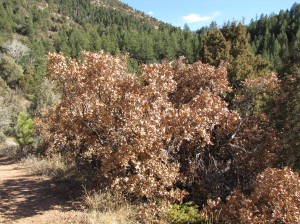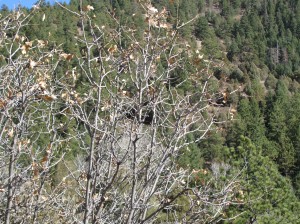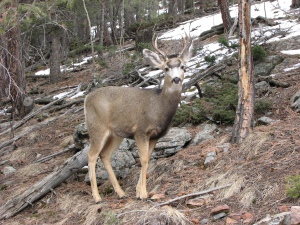Most deciduous trees live up their name and drop their leaves in autumn, but you may have found a curious exception. Some trees or shrubs have leaves that turn brown, but do not fall off. Members of the oak family often exhibit this phenomenon. The leaves that didn’t fall in fall are called marcescent leaves. The term comes from a Latin root that means “withering.”

This Gambel's oak hadn't dropped its leaves in November.
I observed marcescent leaves on the Gambel’s oaks (Quercus gambelii) this past fall. Nearby members of the same species had shed most of their leaves. What survival advantage does this give the plant? Whenever a genetic trait is commonly present, it probably confers some survival advantage. For the oak shrubs along the foothills of the Colorado Rockies, there is a strong threat to survival in the form of mule deer. Cute little bambi grows up to be death to plants on four hooves.
The marcescent leaves on the oaks could help protect them from the onslaught of the large herbivores. In winter, deer are browsers. They eat twigs, buds, and I have even seen them eat the foliage of conifer branches that have blown off the trees or been broken off by heavy snow. The marcescent leaves are thought to deter browsing, probably because they are not tasty and have little food value. The growing points, the meristems, hide behind these dry leaves, protected against drying by their bud scales. In the spring, the old leaves will fall as the new buds start to grow.

This oak, near the first one, had lost most of its leaves by the same time.
However, a study in Denmark showed that the deer there avoided beech and hornbeam branches with marcescent leaves, but not oaks. The dead leaves on the beech and hornbeam branches had a high lignin content. Lignin is a very complex substance that is hard to digest. Perhaps Colorado oaks have less palatable leaves, or the leaves could give a different benefit.

He's cute, but he is murder on plants. Twigs on trees and shrubs are among his favorite foods.
Another theory is that the leaves help hold more wind-blown snow, and therefore bring more moisture to the shrub. In this semi-arid climate, every bit of moisture is important. While this may be a part of why Colorado scrub oaks keep their leaves, it doesn’t really fit the picture for taller oak trees.
Some oak species, notably pin oaks (Quercus palustris) keep their petioles alive through the winter and shed their leaves in spring. In other cases, the petiole appears to be brown and dead. Another factor could be sudden fall freezes that kill the petiole before it has completed the abscission process. There are many steps to abscission, the “cutting away” of the leaves. They involve enzymes, and these protein molecules, as well as cell structures, may be damaged by sudden cold.
It is likely that many factors play into the puzzle of the leaves that didn’t fall in fall. They will, however, fall in spring.